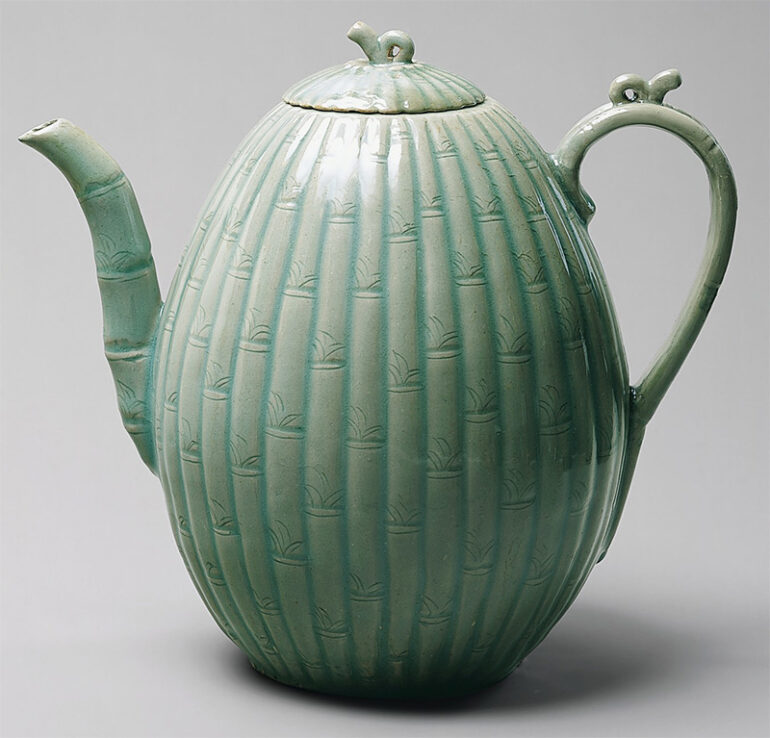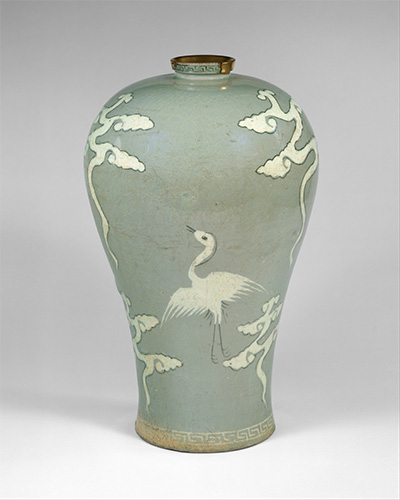Celadon is the pottery and specific glaze used for stoneware items. Celadon is a greenish ceramic glaze that originated in China and was later used in Japan, Korea, and Thailand. Potters apply celadon glaze on porcelain, earthenware, and stoneware. It is a delicate combination of glaze and the right amount of iron oxide fired at high temperatures. The glaze should be refined to prevent other chemicals from altering the color. Potters will get a blue glaze if they use too little iron oxide. Using too much will give an olive or black color to the pottery.
The beauty and artistry of celadon made the ware very popular. Moreover, the Chinese valued them highly because the pottery resembled jade. Further, they believed a celadon dish would change color or break if it contained poisoned food.
Goryeo celadon
During the Goryeo (Koryŏ) period (918 to 1392) in Korea, potters developed their versions of celadons with bluish-green to putty-colored glaze. The Goryeo celadons typically feature lobed forms based on the gourd or melon. However, Korean celadons’ most distinct feature was the inlaid decoration usually found under the glaze, which is not present in Chinese celadon. The designs were cut into the clay, and black and white slip filled the incisions later.
Goryeo potters used diverse inlaid patterns, but most designs were floral, with some having cloud and bird subjects. Celadon boxes usually have isolated flowers with petals radiating symmetrically.
The Goryeo dynasty lasted for more than five centuries, and during that time, celadon comprised the main type of ceramics produced in Korea. The exquisite ware the potters produced distinctly showed the gray-green hue of the celadon glaze. The Goryeo potters owed much of the beauty of their celadon ware to the availability of raw materials, especially the presence of iron in the clay they use, and the quartz, manganese oxide, and iron oxide particles in the glaze, and the firing conditions in their kilns. They produced various types, ranging from plain to undecorated types. They also had distinct incised, mold-impressed, inlaid, and carved designs, aside from various vessels decorated with colorful compounds, including gold, copper oxide (red), and iron oxide (brown or black).
Initial years of development
The potters of Goryeo initially learned much of their technical expertise from China’s Song dynasty’s celadon traditions. In the early days, the Goryeo potters consciously replicate specific stylistic features of the wares from China. By the middle of the 12th century, Goryeo patterns and their patrons preferred native designs.
The marked distinction of Goryeo celadon
The maebyeong, a shapely ceramic vessel with cranes flying among floating clouds on a gorgeous blue-green background, symbolizes Korean celadons produced from 918 to 1392. The beautiful color of the glaze, together with the intricately inlaid embellishment, are the primary features that make Goryeo celadons recognizable and sought-after for several centuries.
Korean ceramics became distinct by carefully adapting and refining the Chinese celadon techniques. Thus, the Goryeo celadon enjoyed high praise from the elites in China, Japan, and Korea. Most Korean celadons displayed in museums today came from archeological finds from excavated royal tombs and palaces. The high value came from the intricate decorative techniques, delicate forms, and vibrant colors that distinguished Goryeo celadons from others.
More advanced technology
Based on archeological evidence, Korean potters’ ceramic technology was more advanced even before the establishment of the Goryeo dynasty. The dedicated potters from the period of the Three Kingdoms (57 BCE to 676 CE) fired their kilns at temperatures of 1000°C or higher, meaning that it was the world’s earliest example of high-fired ceramics.
But it was during the Goryeo period when royal patronage concentrated on the production of celadons. So after modifying the Chinese techniques, the Goryeo potters created their version of celadons, using iron-rich clay to create vessels and a particular glaze comprised of iron oxide, quartz, and manganese oxide particles. They also developed the two-step firing technique to maintain the consistency of the unique blue-green glaze using the traditional mud kiln. First, they employed bisque firing, which dried out and hardened unglazed ware to make them stable for easier handling. Then, in the second step, they fired the glazed vessel in a low-oxygen kiln, which reduced the temperature, allowing them to attain the desired brilliant cool blue-green hue and glossy texture associated with valued Goryeo celadon. On the other hand, celadons from China had a warmer olive-green glaze.
Early Korean artisans gradually developed their aesthetic brand using molds to create ideal shapes and include popular patterns. Then, they developed the incision technique to decorate the clay surface with delicate linear designs.
During the middle of the 12th century, Goryeo potters started using the sanggam or inlay technique to decorate celadons, an unknown technique in China.
But by the 15th century, which was the early part of the Joseon period, the sanggam technique was overtaken by stamp production so they could quickly create smaller patterns. By the 16th century, the inlay and stamping methods were abandoned in favor of coating the vessels with white slip all over or using a wide brush to leave traces of the brush movement partially.
Photo Attribution:
1st & featured image by https://images.metmuseum.org/CRDImages/as/original/h1_1996.471.jpg
2nd image by https://images.metmuseum.org/CRDImages/as/original/DT4857.jpg

